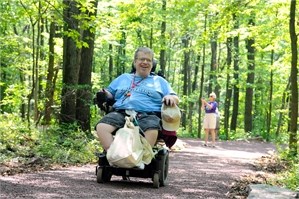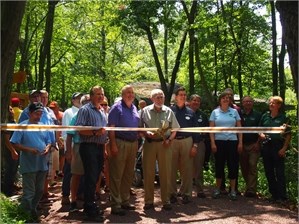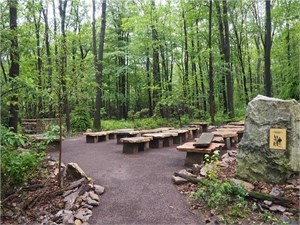Hawk Mountain opens Accessible Trail
Posted on July 28, 2015 in Visitors

Hawk Mountain opened its first-ever Accessible Trail to its closest scenic lookout on Sunday, July 26, following a standing-room-only dedication. The new trail is ADA compliant with a slope or incline that averages 8 percent, below the federal guidelines for national parks. That means Hawk Mountain is setting a new standard for outdoor spaces since no guidelines exist at the state or local level.
"The chance to watch for passing migrants from a Hawk Mountain lookout is the best way to spark an interest in nature and in raptors and it’s our job to connect as many people as possible with that experience," says spokesperson Mary Linkevich.
But it wasn't easy. The grand opening concluded more than two years of planning by the professional staff, volunteers, and planning, accessibility, and land management experts to meet one glaring need: Hawk Mountain could not connect visitors with limited mobility to its big views of the Mountain and the migration. Despite the short walk to the closest lookout, the steep grade limited many. Such individuals often were either left at home or sat alone to wait inside the Sanctuary Visitor Center.
Response to visitor and member feedback

The first donor on the project was Cyrus Klingsberg, who hated that his wife could no longer accompany him on his visits, even the short distance to South Lookout. When he heard about plans for an accessible trail, he immediately offered his support.
Other donations came from the Pennsylvania Department of Conservation and Natural Resources, the Berks County Commissioners through the Community Development Block Grant Program, the Schuylkill County Commissioners, the Pennsylvania Department of Community and Economic Development, the Family of Alfred A. Douglass III, and Cyrus Klingsberg in memory of his wife Vera Klingsberg.
The resulting Accessible Trail to South Lookout is now a new option that veers to the left just after passing through the trailhead entrance, a welcoming area where volunteers greet members and other hikers. The wide pathway here is 900 feet long and six feet wide, enough for two wheelchairs to pass by one another, and bends in a wide, graceful arc through the forest.

Other improvements include benches to rest located every 100 feet, accessible trailside restrooms, upgrades to the Laurelwood Niche, a secluded area for education programs, and improvements at the South Lookout and its viewing platform. The top goal was to maintain a natural feel.
More recent improvements include life-sized silhouettes of raptor species and renaming the trail the Silhouette Trail. This adds an educational component to the trail and also makes it useful and interesting for all visitors.
The trailhead entrance also received a refresher that included dozens of native plantings and a new timber frame trailhead with wrought-iron raptor silhouettes. This area serves as the welcoming spot for visitors who paid their trail fee or members, but immediately beyond, offers two options on the walk to the South Lookout: the ADA Silhouette Trail that bends to the west or the original trail that offers a shorter but steeper climb. Combined, the two create a looped walk that families and others likely will enjoy as well.
Features of the ADA-compliant Silhouette Trail:
Six-foot-wide, smooth path with benches to rest along the way.
The existing stone and earth viewing platform at South Lookout, which previously used wire cages to hold large retaining rocks, replaced with native stone from Hawk Mountain and with new bench seating.
The original earthen trail to the South Lookout remains but has been repacked and graded during construction.
Accessibility to the trailside restrooms stretches from the trail head entrance and also is ADA compliant.
The Laurelwood Niche, a gathering area for education programs, also received an upgrade, is accessible, and connects to both the new trail and the existing trail.
A new timber frame trail entrance compliments the same style recently added at the Native Plant Garden entrance.
More than 200 native plantings improve the entrance and accent areas along the Silhouette Trail.
Following the Hawk Mountain Land Management Plan, all native plantings were removed prior to construction, stored, and replanted. Invasive species were removed.
All workers on the project were required to complete wildlife sensitivity training with a strong focus on reducing the spread of invasive plants. Only those individuals who wore the training-complete sticker were allowed on the project site.